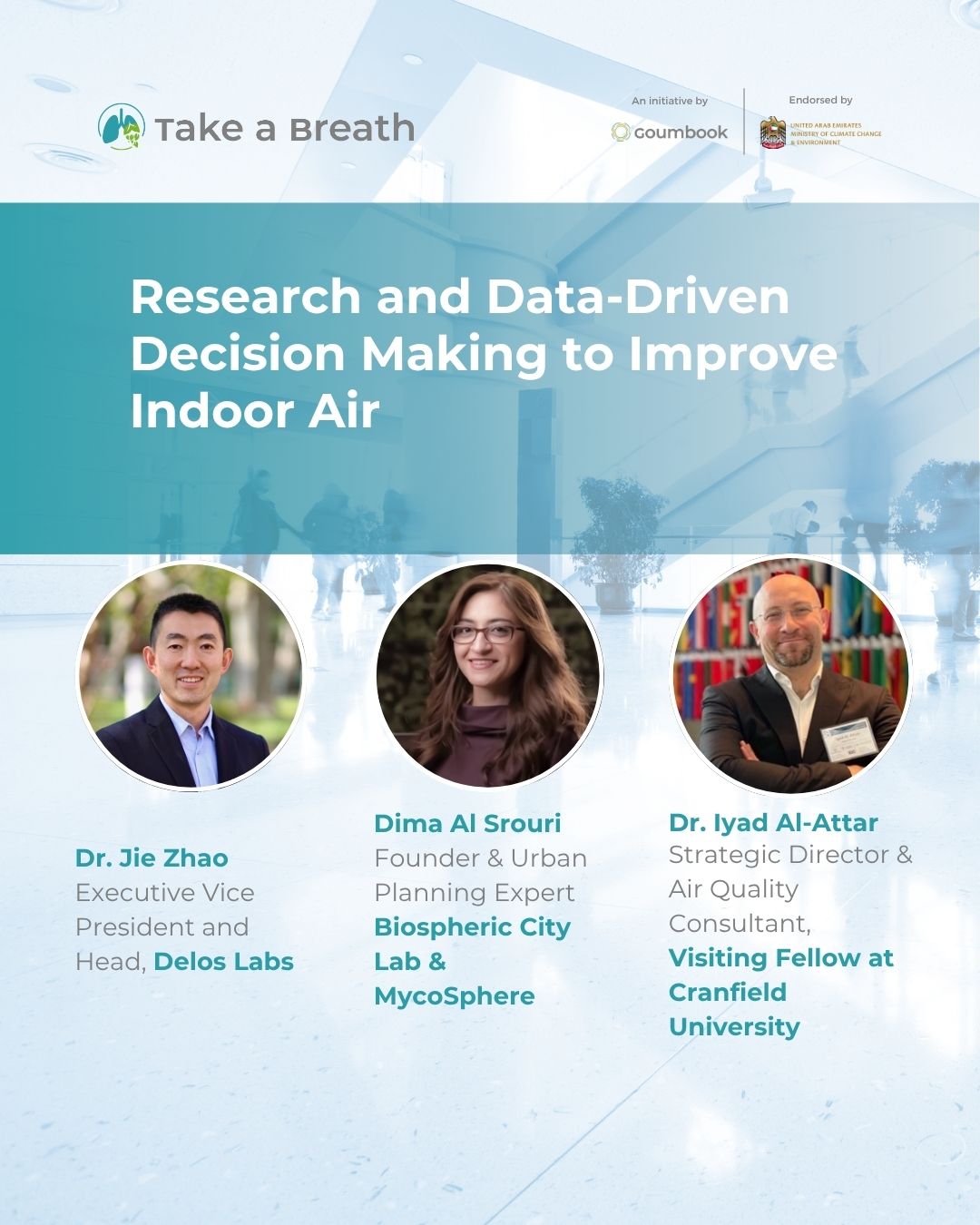Introduction
In a world where we spend over 90% of our time indoors, the quality of the air we breathe is crucial for our health and well-being. The recent webinar series, “Research and Data-Driven Decision Making to Improve Indoor Air” organized by Goumbook, delves into the intricate connections between urban planning, technology, and indoor air quality. This blog post summarizes the key insights from the second session, focusing on research and data-driven decision-making to enhance indoor air quality.
The Invisible Thread: Urban Air Quality
Lama Saleh, the Director of Programme Development and Partnerships at Goumbook, opened the session by highlighting the importance of air quality as a connector between cities, buildings, and the human body. The session featured distinguished experts, including Ms. Dima Al Srouri, Urban planning expert & founder, Biospheric City Lab / MycoSphere, Dr. Jie Zhao, VP & Head of Delos Labs, and Dr. Iyad Al-Attar, Air Quality Consultant, Visiting Fellow at Cranfield University, who provided insights into urban planning, the WELL building standard, and air filtration technologies.
Urban Planning and Air Quality
Ms. Dima Al Srouri emphasized the macro-level influence of urban planning on air quality. She noted that 99% of the global population breathes air that exceeds WHO limits, leading to profound health implications. By implementing sound urban planning principles, such as mixed-use developments and green infrastructure, cities can mitigate pollution at its source. Dima shared examples, such as Barcelona’s “superblocks,” which limit vehicle access, resulting in significant reductions in nitrogen oxide and particulate matter.
The Role of the WELL Building Standard
Dr. Jie Zhao provided an overview of the WELL Building Standard, which focuses on how indoor environments impact human health. He explained that air quality is a critical component of this standard. With millions of deaths attributed to air pollution annually, improving indoor air quality through enhanced design, ventilation, and filtration systems is crucial. Zhao encouraged individuals to invest in air purifiers to improve home environments and advocated for policy changes that prioritize air quality monitoring in vulnerable populations.
Filtration Technologies and Systemic Change
Dr. Iyad Al-Attar discussed the technical aspects of air filtration and the importance of understanding outdoor pollutants in order to design effective indoor systems. He argued for a more holistic approach that considers the entire lifecycle of air filtration solutions and encourages the integration of technology with urban planning. Iyad highlighted the need for a responsive system that adapts to human occupancy and varying air quality conditions.
Recommended Actions for Improvement
As the session concluded, the speakers shared actionable insights:
- Start with Urban Planning: Prioritize sustainable designs that minimize pollution sources and enhance natural ventilation.
- Invest in Air Quality Monitoring: Individuals should consider home air purifiers, while governments can implement policies to monitor air quality, especially in vulnerable communities.
- Holistic Filtration Strategies: Understand the specific pollutants in your environment to select appropriate air filtration systems that are fit for purpose.
Conclusion
The “Breathing into the Future” webinar series highlights the urgent need for collaborative action to improve air quality in our cities. By integrating urban planning, technology, and health considerations, we can create healthier indoor spaces for resilient communities. As we move forward, let us prioritize air quality as a fundamental aspect of urban living, ensuring that clean air is not just a privilege but a right for all.
Stay tuned for the next session in Fall 2025, where we’ll explore innovative technological solutions to enhance indoor air quality, designed not just for smarter buildings, but for healthier, more comfortable lives.
If you want to learn more, watch the full interview below:

